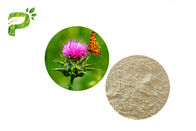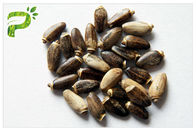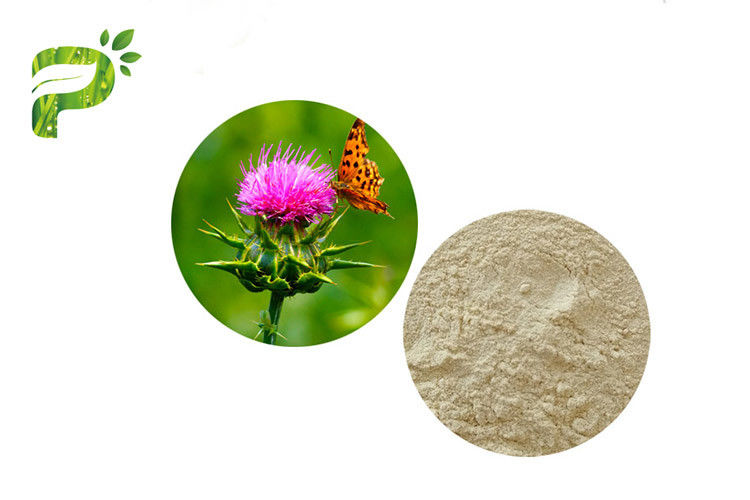Silymarin & Silybin CAS No. 22888 70 6 of Milk Thistle Plant Extract Preventing Liver Disorder
Plant Source of Milk Thistle Extract:
Milk thistle is commonly found growing wild in a variety of settings, including roadsides. The Latin name is Silybum marianum. The seeds of the dried flower are used. The active ingredient in the plant is a flavonoid called silymarin, an antioxidant said to protect liver cells from toxins. Silymarin apparently promotes liver cell protein synthesis and decreases the oxidation of glutathione. The plant's flowers and seeds have been used for more than 2,000 years to treat disorders of the liver and gallbladder.
Basic Info:
| Product Name |
Milk Thistle Extract |
| Latin Name |
Silybum marianum(Linne) Gaertner |
| Part Used |
Seed |
| Solvent Used |
Ethanol & Water |
| Active Ingredient |
Silybin |
| CAS No. |
22888-70-6 |
| Molecular Weight |
482.44 |
| Molecular Formula |
C25H22O10 |
| Specification |
90%, 95%, 98% |
| Test Method |
HPLC |
| Appearance |
Off white or slight yellow powder |
| Packing size |
25kg/drum, 1kg/bag |
| Shelf Life |
3 years |
| Country of Origin |
China |
Silibinin (INN), also known as silybin (both from Silybum, the generic name of the plant from which it is extracted), is the major active constituent of silymarin, a standardized extract of the milk thistle seeds, containing a mixture of flavonolignans consisting of silibinin, isosilibinin, silicristin, silidianin, and others. Silibinin itself is a mixture of two diastereomers, silybin A and silybin B, in approximately equimolar ratio. The mixture exhibits a number of pharmacological effects, particularly in the liver.
Chemical Structurer of Silybin A and Silybin B:


Certificate of Analysis of Silybin 90%:
| Product |
Milk Thistle Extract |
Ingredient |
Silybin |
| Latin Name |
Silybum marianum(Linne) Gaertner |
| Batch no. |
P0130-220505 |
Batch Qty |
500kgs |
| MFG Date |
2022.05.03 |
Report Date |
2022.05.25 |
| Analysis: |
| Items |
Specification |
Result |
| Assay (HPLC) |
≥90% |
91.47% |
| Charaters |
Similar to white or slight yellow powder, no smell |
Complies |
|
Identification
(1) Ferric Chloride Reaction
(2) UV Absorption
(3) Infra-red Absorption
|
Brown precipitate
Max 288nm/Min252nm
Same as the standard
|
Complies
Complies
Complies
|
| Heavy Metals |
≤20ppm |
Complies |
| Cd |
<5.0ppm |
Complies |
| Hg |
<0.2ppm |
Complies |
| Pb |
<0.1ppm |
Complies |
| As |
<2.0ppm |
Complies |
| Loss on Drying (2h130℃) |
≤3.0% |
2.23% |
| Sulphated Ash |
≤0.20% |
0.10% |
| Melting Point |
181-185℃ |
Complies |
|
Organic Solvents Residue
Ethanol
|
≤0.5% |
0.29% |
| Microbiological Control |
| Total Plate Count |
1000cfu/g |
25cfu/g |
| Yeasts&Molds |
100cfu/g |
10cfu/g |
| Salmonella |
Negative |
Complies |
| E.Coli |
Negative |
Complies |
| Pseudomonas aeruginsa |
Negative |
Complies |
| Staphylococcus aeruginsa |
Negative |
Complies |
| Conclusion |
QUALIFIED |
| Packing |
25kg/drum; Total: 20 drums. |
| Storage |
Keep in cool dry place, avoid sun and heat. |
| Shelf Life |
3 years from original packing condition. |
Applications:
Liver protection
Silibinin is available as drug (Legalon SIL (Madaus) (D, CH, A) and Silimarit (Bionorica), a Silymarin product) in some EU countries and used in the treatment of toxic liver damage (e.g. IV treatment in case of death cap poisoning); as adjunctive therapy in chronic hepatitis and cirrhosis.
Silibinin is under investigation to see whether it may have a role in cancer treatment (e.g. due to its inhibition of STAT3 signalling).
Silibinin also has a number of potential mechanisms that could benefit the skin. These include chemoprotective effects from environmental toxins, anti-inflammatory effects, protection from UV induced photocarcinogenesis, protection from sunburn, protection from UVB-induced epidermal hyperplasia, and DNA repair for UV induced DNA damage (double strand breaks).

 Your message must be between 20-3,000 characters!
Your message must be between 20-3,000 characters! Please check your E-mail!
Please check your E-mail!  Your message must be between 20-3,000 characters!
Your message must be between 20-3,000 characters! Please check your E-mail!
Please check your E-mail! 


